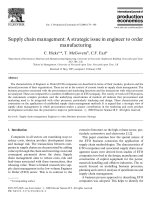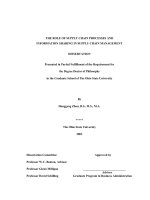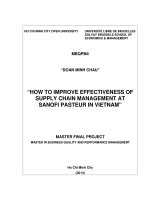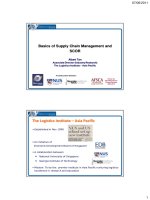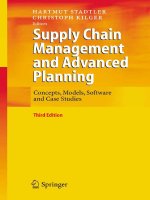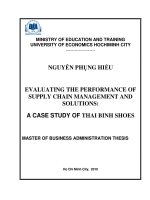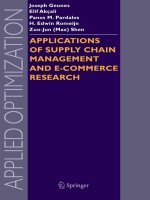Lecture E-Commerce - Chapter 16: B2B E-commerce - Supply chain management and collaborative commerce
Bạn đang xem bản rút gọn của tài liệu. Xem và tải ngay bản đầy đủ của tài liệu tại đây (1.45 MB, 40 trang )
CSC 330 E-Commerce
Teacher
Ahmed Mumtaz Mustehsan
GM-IT CIIT Islamabad
Virtual Campus, CIIT
COMSATS Institute of Information Technology
T1-Lecture-16
T1-Lecture-16
Ahmed Mumtaz Mustehsan
Copyright © 2010 Pearson Education, Inc
1-1
T1-Lecture-16
B2B E-commerce: Supply Chain
Management and Collaborative
Commerce
Chapter-12
For Lecture Material/Slides Thanks to: Copyright © 2010 Pearson Education, Inc
T1-Lecture-16
Ahmed Mumtaz Mustehsan
Copyright © 2010 Pearson Education, Inc
1-2
B2B E-Commerce & supply Chain Management
B2B Trade in 2010 is US only was $ 16 Trillions and with
B2B e-commerce was $ 3.6 Trillions.
Some Basic Terminologies:
Total Inter-firm Trade
The total flow of value among firms.
B2B Commerce
All types of computers enabled inter firm trade.
Internet-based B2B Commerce
The portion of B2B commerce that is enabled by the
internet.
Automated Order Entry systems
Involved the use of telephone modems to send digital
orders.
T1-Lecture-16
Ahmed Mumtaz Mustehsan
Copyright © 2010 Pearson Education, Inc
1-3
B2B E-Commerce & supply Chain Management
Some Basic Terminologies: (Continued)
Selle- side Solutions
Seller biased market that are owned by ; and show
only goods from, a single seller.
EDI (Electronic Data Interchange)
A communication standard for sharing business
documents and settlement information among a small
number of firms.
Buyer-side solutions:
Buyer biased market that are owned by buyers and
that aimed to reduce the procurement cost of supplies
for buyers.
T1-Lecture-16
Ahmed Mumtaz Mustehsan
Copyright © 2010 Pearson Education, Inc
1-4
B2B E-Commerce & supply Chain Management
Some Basic Terminologies: (Continued)
Vertical market
One that provides expertise and products for specific
industry.
Horizontal market
Market that serve many different industries.
B2B Electronics Storefronts
Online catalogue of products made available to the
public marketplace by a single supplier.
Net Marketplace
Brings hundreds to thousands of suppliers and buyers
into a single internet-based environment to conduct
trade.
T1-Lecture-16
Ahmed Mumtaz Mustehsan
Copyright © 2010 Pearson Education, Inc
1-5
B2B E-Commerce & supply Chain Management
Some Basic Terminologies: (Continued)
Private Industrial Networks/
Private Trading Exchange (PTX)
Internet based Communications environments that
extend far beyond procurement to encompass truly
collaborative commerce.
T1-Lecture-16
Ahmed Mumtaz Mustehsan
Copyright © 2010 Pearson Education, Inc
1-6
The Growth of B2B- Industry Forecasts
In the period 2010 to 2014 B2B E-Commerce projected
growth was 30% to 35% of total inter firm trade.
Not all industries similarly affected by B2B
e-commerce
Not all industries would benefit equally
Factors influencing move to e-commerce
Significant utilization of EDI
Large investments in IT and Internet infrastructure
e.g., aerospace and defense, computer, and industrial
equipment
Market concentrated on purchasing and/or selling or
both are ripe for B2B growth. e.g., energy, chemical
industries, Health Insurance (National Medical Record)
T1-Lecture-16
Ahmed Mumtaz Mustehsan
Copyright © 2010 Pearson Education, Inc
1-7
Potential Benefits of B2B E-commerce
Lower
administrative costs
Lower
search costs for buyers
Reduced
inventory costs
◦Increasing competition among suppliers
(increasing price transparency)
◦Reducing inventory carried
Lower
transaction costs:
◦Eliminating paperwork
◦Automating parts of procurement process
T1-Lecture-16
Ahmed Mumtaz Mustehsan
Copyright © 2010 Pearson Education, Inc
1-8
Potential Benefits of B2B E-commerce
Increased
production flexibility by ensuring just-intime parts delivery
Improved
quality of products by increasing
cooperation among buyers and sellers
Decreased
product cycle time by sharing of
designs and production schedules
Increased
opportunities for collaborating with
suppliers and distributors
Greater
T1-Lecture-16
price transparency
Ahmed Mumtaz Mustehsan
Copyright © 2010 Pearson Education, Inc
1-9
The Procurement Process and the Supply Chain
Procurement process:
The way firms purchase materials they need, to make
products
Supply chain:
Firms that purchase goods, their suppliers, and their
suppliers’ suppliers, and relationships and processes
involved
Steps in procurement process:
Deciding who to buy from and what to pay
Completing transaction
T1-Lecture-16
Ahmed Mumtaz Mustehsan
Copyright © 2010 Pearson Education, Inc
110
The Procurement Process
T1-Lecture-16
Ahmed Mumtaz Mustehsan
Copyright © 2010 Pearson Education, Inc
111
Types of Procurement
Firms purchase two types of goods
1.Direct goods: integrally involved in production
process
2.Indirect goods: all goods not directly involved in
production process (MRO goods)
Firms use two methods to purchase
1.Contract purchasing:
◦ Involves long-term written agreements to
purchase specified products, with agreed-upon
terms and quality
1.Spot purchasing:
◦ Involves purchase of goods based on
immediate needs in larger marketplaces that
involve many suppliers
T1-Lecture-16
Ahmed Mumtaz Mustehsan
Copyright © 2010 Pearson Education, Inc
112
Types of Procurement
Procurement
is highly information intensive and
labor intensive—3.3 million U.S. workers
Use
of Internet can simplify process and reduce
Search, Research, Negotiating costs
Multi-tier
supply chain
◦Complex series of transactions between firm and
thousands of suppliers
T1-Lecture-16
Ahmed Mumtaz Mustehsan
Copyright © 2010 Pearson Education, Inc
113
The Multi-Tier Supply Chain
T1-Lecture-16
Ahmed Mumtaz Mustehsan
Copyright © 2010 Pearson Education, Inc
114
The Role of Existing Legacy
Computer Systems
Legacy computer systems
Generally older mainframe and minicomputer systems
used to manage key business processes within firm
MRP systems (Materials Requirements Planning)
Enable firms to predict, track, and manage parts of
complex manufactured goods. Generate Production
schedule and required BoM to meet the schedule.
ERP systems (Enterprise Resource planning)
More sophisticated MRP systems that include Human
Resources and Financial components
Received Purchase Order is entered in to ERP to
determine the BoM, schedule, HR requirements,
Invoice against P.O. and payments to the suppliers.
T1-Lecture-16
Ahmed Mumtaz Mustehsan
Copyright © 2010 Pearson Education, Inc
115
Trends in Supply Chain Management
and Collaborative Commerce
Supply
chain management (SCM):
◦Wide variety of activities that firms and industries use
to coordinate key players in their procurement
process
Major
developments in SCM
1.Supply chain simplification
2.Electronic Data Interchange
3.Supply Chain Management systems
4.Collaborative Commerce
T1-Lecture-16
Ahmed Mumtaz Mustehsan
Copyright © 2010 Pearson Education, Inc
116
1. Supply Chain Simplification
Simplified Procurement Process
Essential for Just-In-Time production models
Typically achieved by:
Working with strategic group of suppliers to reduce
product and administrative costs, while improving quality
Purchasing under long-term contracts; ensured certain
business to the selected supplier against; specified quality,
cost, and timing goals.
May involve Joint product development and design
◦Integration of computer systems
◦Tight coupling: A method for ensuring that a suppliers
precisely deliver the order parts, at a specific time and
particular location, to ensure the production process is
not delayed due to lack of parts.
T1-Lecture-16
Ahmed Mumtaz Mustehsan
Copyright © 2010 Pearson Education, Inc
117
2. Electronic Data Interchange (EDI)
Broadly
defined communications protocol for
exchanging documents among computers
Stage 1: 1970s–1980s
Document automation (B2B e-commerce existed much
before Internet)
Stage 2: Early 1990s
Document elimination
Stage 3: Mid-1990s
Move toward continuous replenishment/access model
Today:
EDI provides for exchange of critical business
information between computer applications supporting
wide variety of business processes
Firms
T1-Lecture-16
using XML to define EDI.
Ahmed Mumtaz Mustehsan
Copyright © 2010 Pearson Education, Inc
118
The Evolution of EDI as a B2B Medium
1. Standardization of
Documentation such as P.O,
invoice, shipping documents,
payments exchanges
electronically.
2. Documents were replaced
with Production Process,
Schedule and Inventory
3. Suppliers were given online
access to the production
system and inventory;
Eliminated manual procurement
T1-Lecture-16
Ahmed Mumtaz Mustehsan
Copyright © 2010 Pearson Education, Inc
119
2. Electronic Data Interchange (EDI)
Strength and Weakness of EDI
The ability to support direct commercial transection
among strategically related firms is both a strength as
well as a weakness ? Strength we have studied !!
The weakness:
Not suited for the development of e-marketplace, a
digital arena to negotiate best price.
Permit bilateral not multilateral dynamic relationship of a
tru marketplace.
Does not provide price transparency among a large
number of suppliers.
Does not have rich communication (e-mail, graphic).
Expensive proposition requires small-firms to implement
EDI to supply large firms.
T1-Lecture-16
Ahmed Mumtaz Mustehsan
Copyright © 2010 Pearson Education, Inc
120
3. Supply Chain Management Systems
Focused upon ERP system and Continuous
Replenishment:
SCM,
Continuously link activities of buying, making,
and moving products from suppliers to purchasing firms
Also Integrates demand side of business equation by
including order entry system in the process
With SCM system and continuous replenishment, the
inventory is eliminated and production begins only when
order is received (Demand manufacturing)
Hewlett Packard’s SCM system: elapsed time from
order entry to shipping PC is 48 hours.
The delivery through third party is monitored as it is
tracked through manufactured SCM system.
T1-Lecture-16
Ahmed Mumtaz Mustehsan
Copyright © 2010 Pearson Education, Inc
121
Supply Chain Management Systems
T1-Lecture-16
Ahmed Mumtaz Mustehsan
Copyright © 2010 Pearson Education, Inc
122
Collaborative Commerce
Use
of digital technologies enabling organizations to
collaboratively design, develop, build, and manage
products through life cycles
Direct
extension of SCM systems and supply chain
simplification
Involves
move from transaction focus to relationship
focus among supply chain participants
Unlike
EDI, more like an interactive teleconference
among members of supply chain.
Involves
customers and suppliers in the development
of products for the most parts with the development of
rich communication environment.
Example:
T1-Lecture-16
Group Dekko
Ahmed Mumtaz Mustehsan
Copyright © 2010 Pearson Education, Inc
123
Elements of a Collaborative Commerce System
T1-Lecture-16
Ahmed Mumtaz Mustehsan
Copyright © 2010 Pearson Education, Inc
124
Two Types of Internet-Based B2B Commerce
1. Net marketplaces:
Bring together potentially thousands of sellers and
buyers in single digital marketplace operated over Internet
Transaction-based
Support many-to-many as well as one-to-many
relationships
2. Private industrial networks:
Bring together small number of strategic business
partner firms that collaborate to develop highly efficient
supply chains
Relationship-based
Support many-to-one and many-to-few relationships
Largest form of B2B e-commerce.
Generate 10 times the reveneue as that of Net
marketplace.
T1-Lecture-16
Ahmed Mumtaz Mustehsan
Copyright © 2010 Pearson Education, Inc
125
